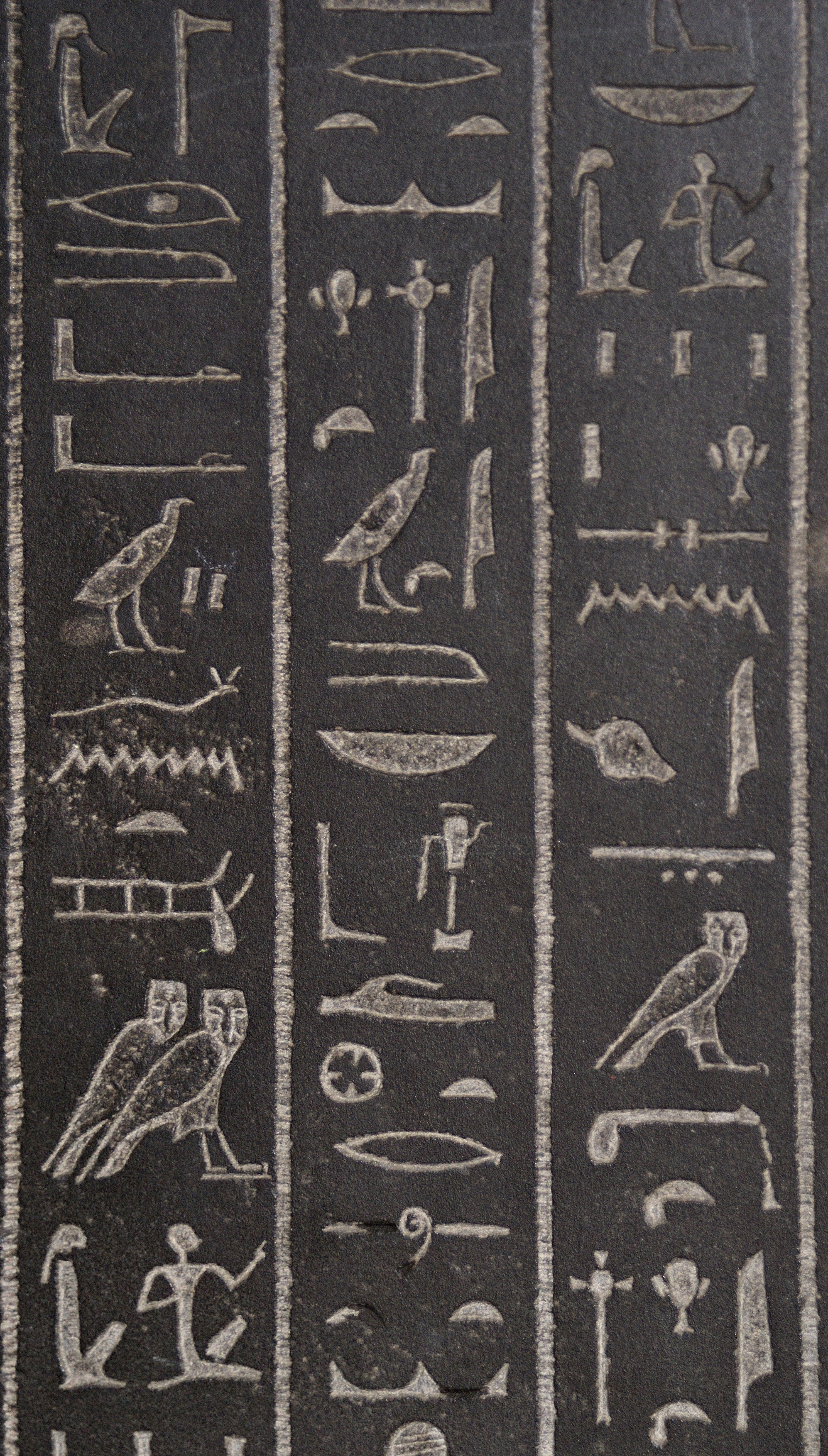Quadrat (hieroglyph Block) on:
[Wikipedia]
[Google]
[Amazon]
 A quadrat block (or ''quadrate block'') is a virtual
A quadrat block (or ''quadrate block'') is a virtual
 An example of five lines of text from the
An example of five lines of text from the N5:Z1-(day-1)-(tall-narrow-block)
nfr-t:D21-(up to)-(square-block)
O4*N5:Z1*Z1*Z1*Z1*Z1-(day-5)-(square-block)
:The three blocks:
N5:Z1-nfr-t:D21-O4*N5:Z1*Z1*Z1*Z1*Z1-(day-1-up to-day-5)
File:Egypte louvre 222 hieroglypes.jpg,
''Hotep, "Amun-Ra"''
(htp-t-p, i-mn-n-Ra-(stroke) File:Egypt Hieroglyphe6.jpg, A Ptolemy, cartouche with various quadrate blocks. File:Egypte louvre 144 hieroglyphes.jpg, Finely executed hieroglyphs in sunken relief. Line 3, 2nd block in (from left), the H-Ra -H blockEternity (hieroglyphs)
/ref>
''Glyphotext'' definition for 'quadrat'
Egyptian hieroglyphs
 A quadrat block (or ''quadrate block'') is a virtual
A quadrat block (or ''quadrate block'') is a virtual rectangle
In Euclidean plane geometry, a rectangle is a quadrilateral with four right angles. It can also be defined as: an equiangular quadrilateral, since equiangular means that all of its angles are equal (360°/4 = 90°); or a parallelogram containi ...
or square
In Euclidean geometry, a square is a regular quadrilateral, which means that it has four equal sides and four equal angles (90-degree angles, π/2 radian angles, or right angles). It can also be defined as a rectangle with two equal-length adj ...
in Egyptian hieroglyphic
Egyptian hieroglyphs (, ) were the formal writing system used in Ancient Egypt, used for writing the Egyptian language. Hieroglyphs combined logographic, syllabic and alphabetic elements, with some 1,000 distinct characters.There were about 1,00 ...
text.
The glyphs (hieroglyphs) can be variable in number within the ''virtual block'', though they are often proportioned according to variable standardized rules of scribal
A scribe is a person who serves as a professional copyist, especially one who made copies of manuscripts before the invention of automatic printing.
The profession of the scribe, previously widespread across cultures, lost most of its promi ...
methods.
The definition for the block in ''Illustrated Hieroglyphics Handbook'' by Schumann-Antelme and Rossini, is: "A 'quadrate' is a virtual square, which although not drawn, guides the hand of the scribe. Hieroglyphs must be aesthetically positioned within the quadrate and their size must be proportioned accordingly. They form groups that are pleasing to the eye and based on the laws of balance."
Rosetta Stone closeup
 An example of five lines of text from the
An example of five lines of text from the Rosetta Stone
The Rosetta Stone is a stele composed of granodiorite inscribed with three versions of a Rosetta Stone decree, decree issued in Memphis, Egypt, in 196 BC during the Ptolemaic dynasty on behalf of King Ptolemy V Epiphanes. The top and middle te ...
, (lines 9, 10, 11, 12, 13), shows a width of about six to seven virtual blocks. Line 12, (fourth line) is illustrative of the variable size, in this case the widths, of the 'virtual quadrate blocks'.
:The time of the festivals are stated as: "...day 1 up to day 5...", (three blocks)
In running text blocks, prepositions can sometimes start or end a block, but may be part of the next block's translation. Running texts will sometimes actually end in the very middle of the next square. This can be accomplished because some of the prepositions come in vertical and horizontal forms:
O34-s-(horizontal-vert-eSSes) , M-m-(horizontal-vert-eMs) , N-n-(vert-horizontal-eNs)
(See: N-red crown (n hieroglyph)
Deshret ( egy, dšrt "Red One") was the formal name for the Red Crown of Lower Egypt and for the desert Red Land on either side of Kemet (Black Land), the fertile Nile river basin. When combined with the Hedjet (White Crown) of Upper Egypt, it fo ...
, N-water ripple (n hieroglyph)
The total number of distinct Egyptian hieroglyphs increased over time from several hundred in the Middle Kingdom to several thousand during the Ptolemaic Kingdom.
In 1928/1929 Alan Gardiner published an overview of hieroglyphs, Gardiner's sign ...
)
Amun-Ra's block
Most commonly in hieroglyphs, M17-Y5:N35 , (or M17-Y5::N35 ), and i-Y5:N35:N5*Z1
. Note how the vertical hieroglyph for ''reed''-(the ''i'' for 'Amun') is actually part of the block, though at its side.
Amun
Amun (; also ''Amon'', ''Ammon'', ''Amen''; egy, jmn, reconstructed as (Old Egyptian and early Middle Egyptian) → (later Middle Egyptian) → (Late Egyptian), cop, Ⲁⲙⲟⲩⲛ, Amoun) romanized: ʾmn) was a major ancient Egyptian ...
is referenced without Amun-Ra. The two blocks for Amun and Amun-Ra are: Register
Register or registration may refer to:
Arts entertainment, and media Music
* Register (music), the relative "height" or range of a note, melody, part, instrument, etc.
* ''Register'', a 2017 album by Travis Miller
* Registration (organ), th ...
1, (line 1, right to left), blocks 2 and 3:''Hotep, "Amun-Ra"''
(htp-t-p, i-mn-n-Ra-(stroke) File:Egypt Hieroglyphe6.jpg, A Ptolemy, cartouche with various quadrate blocks. File:Egypte louvre 144 hieroglyphes.jpg, Finely executed hieroglyphs in sunken relief. Line 3, 2nd block in (from left), the H-Ra -H block
/ref>
See also
*Egyptian hieroglyphs
Egyptian hieroglyphs (, ) were the formal writing system used in Ancient Egypt, used for writing the Egyptian language. Hieroglyphs combined logographic, syllabic and alphabetic elements, with some 1,000 distinct characters.There were about 1,00 ...
* Egyptian Hieroglyph Format Controls
Egyptian Hieroglyph Format Controls is a Unicode block containing formatting characters that enable full formatting of quadrats for Egyptian hieroglyphs
Egyptian hieroglyphs (, ) were the formal writing system used in Ancient Egypt, used for ...
(Unicode block)
References
*Budge. ''The Rosetta Stone,'' E.A.Wallace Budge, (Dover Publications), c 1929, Dover edition(unabridged), 1989. (softcover, ) *Schumann-Antelme, and Rossini, 1998. ''Illustrated Hieroglyphics Handbook
The ''Illustrated Hieroglyphics Handbook'' is part of a new genre of books focused on Egyptian hieroglyphs. The book is a graphics based book with four to seven word examples of each Egyptian hieroglyph; the words are graphically explained for ea ...
'', Ruth Schumann-Antelme, and Stéphane Rossini. c 1998, English trans. 2002, Sterling Publishing Co. (Index, Summary lists (tables), selected uniliterals, biliterals, and triliterals.) (softcover, {{ISBN, 1-4027-0025-3)
External links
''Glyphotext'' definition for 'quadrat'
Egyptian hieroglyphs